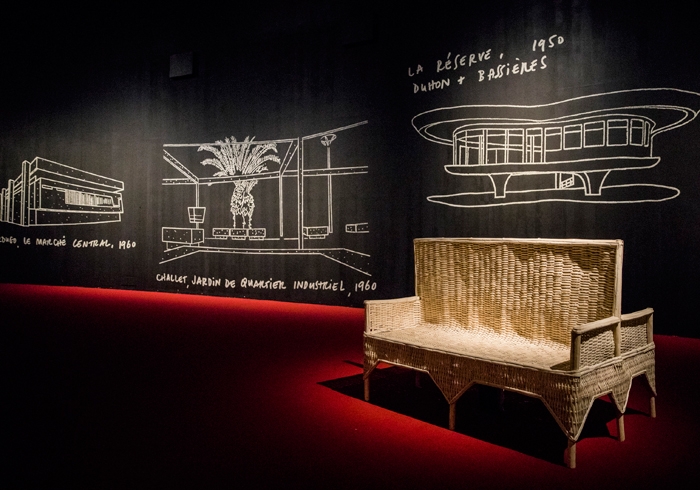The city of Agadir was destroyed in 1960, by an earthquake that lasted 15 seconds. Brittle stone buildings collapsed, burying 15,000 people alive, just before midnight, in their beds.
In the Barbican’s Curve gallery, Moroccan artist Yto Barrada has etched the white outlines of 11 buildings into its long wall, which appears like a giant, curved blackboard. The mural, documents the reconstruction of the city by a group of French-Moroccan architects – notably, Jean-François Zevaco and Elie Azagury – in Le Corbusier’s Brutalist style.
Twelve wicker seats, fabricated by weavers in Tangier, are laid out along the gallery’s promenade. Some look like kissing chairs, others like simple benches. Voices emanating from hidden loudspeakers read from the Berber Mohammed Khaïr-Eddine’s experimental fiction Agadir (1967). The voices describe thousands of bodies putrefying in the heat, corpses cleared away by soldiers, bulldozers and rats. Khaïr-Eddine referred to his writing as ‘guerrilla linguistics’ – a collision of reportage, confession and poetry, splicing French with Arabic – and his cast (which includes a Berber queen, a fortune-teller and a pirate, among others) debates the reform of the city’s buildings and political structures. At intervals across the exhibition, actors appear in pyjamas, roaming the corridor like patients in a ward.
Barrada is an artist-hoarder, visiting flea markets and municipal archives, filling her studio with fieldwork. An interest in fossils, museology and urban planning led to fictional guidebooks – first, A Guide to Trees (2011) (advice on how to groom a city for visiting dignitaries), and later, A Guide to Fossils (2015). As a trained anthropologist, Barrada’s penchant for systemfinding shows. A mobile made of baskets, hanging at the end of the promenade, is an archive of wicker forms.
On an adjacent wall, a film plays footage of rescue missions harvested from newsreels, and panoramas of the devastated city, showing the spectacle of its destruction. Dazed citizens describe the sound of the quake. One sequence, in which Le Corbusier himself visits the remains, verges on ruin-lust.
A critique of colonial modernism twists through Barrada’s work, but softly. More palpable is the task of playful abstraction: in a series of paper collages opposite the mural, international press materials from the days following the earthquake are cut up, reassembled and made into jagged forms. Like Khaïr- Eddine’s ‘guerrilla linguistics’, these reimaginings of the disaster take refuge in abstraction and experiment, and refrain from explicit context – a strategy of resistance, perhaps. Only on later reading do I fully apprehend the irony of the international rescue missions: it was the Agadir Crisis of 1911 that sparked four decades of French colonial rule. In 1960, just four years after the country regained its independence, foreign troops aid the relief efforts, nurses to Agadir’s wound. Today, Agadir is a city of white boulevards, European-style cafés and hotels along the beachfront. The Berber city has all but vanished.
Yto Barrada: Agadir, The Curve, Barbican Centre, London, 7 February – 20 May 2018
From the April 2018 issue of ArtReview
